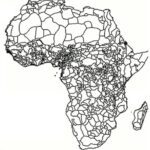A ragged horizon, chunks of rubble protruding from the ground like rotten teeth, and refugees resembling walking skeletons. This is how Sudanese artist Adlan Yousif (33) remembers his birthplace of Al-Fashir, in the western region of Darfur.
From his place of exile in the Kenyan capital, Nairobi, he points to a metal artwork depicting the city. Using springs, bolts, spark plugs, pipes, and hinges, Adlan brings that tragedy to life. “Some people call me the metal devil.”
For over five hundred days, Al-Fashir has been under siege and starvation. The city has become a symbol of the humanitarian tragedy in Sudan. Some 260,000 civilians—half of them children—are completely surrounded by the paramilitary Rapid Support Forces (RSF). Al-Fashir is the last city in Darfur still controlled by the Sudanese government army, which is backed by a coalition of former rebel groups.
Since 2023, the RSF has been waging war against the government army, of which they were once an ally. They are blocking all forms of aid, leaving thousands of children suffering from acute malnutrition. Hospitals are being shelled, and markets and refugee camps are repeatedly attacked. Doctors Without Borders, in a report published in July, called it an “ethnically motivated and genocidal” siege. The UN has since called Al-Fashir an “epicenter of child suffering.”
Journalist Ahmed Mohamed Abdalla (30) is documenting this disaster on film. He fled Al-Fashir a few months ago. Now, along with half a million other residents, he resides in Tawilah, a town about sixty kilometers west of the besieged city. “Every day, I interview families arriving from Al-Fashir,” he says over the phone. “The situation, both in Al-Fashir and in Tawilah, is utterly inhumane. It’s terrible.”
Wandering Souls
In June, a UN convoy of fifteen trucks carrying food was bombed en route to Al-Fashir. What remained was looted. Traders no longer dare to enter the market. The price of millet is 25 times higher than usual, and residents are eating animal feed to survive. People are dying of hunger every day.
The RSF is targeting not only civilians, but also medical posts already overwhelmed with wounded, and markets and volunteer soup kitchens. Medicine is as scarce as aid workers.
One of the hundreds of thousands of people sheltering in IDP camps around Al-Fashir is Mona Idris (30). She witnessed firsthand how the militia attacked the nearby Zamzam camp in March. “The RSF soldiers killed everyone they came across,” she says by phone. “I grabbed my two daughters, ran to a neighbor’s house, and hid in her shelter. Anyone who was sick or wounded was killed on the spot, because the RSF thought they were part of the Joint Forces [rebel groups supporting the government army]. When I crawled out of the shelter, I saw my house go up in flames.”
Artist Yousif rubs his face, which always seems sad. “When I hear something, images immediately appear in my mind,” he says, pointing to a sculpture depicting half-faced women. The cracks and fractures in these faces represent never-ending traumas, sustained through sexual violence. “These are the wandering souls, carried on the shoulders of rust and memories,” he explains. “Scrap metal in its most basic form allows me to express this tragedy by shaping this hard, rusty, and cold material into an expressive, poetic form.”
Sexual Violence
On the escape route from Al-Fashir, photojournalist Abdalla documented cases of sexual violence against women and girls traveling along these routes. “Men who were at the roadblock also had to work on farms owned by RSF fighters if they could not pay.
In Tawilah, too, the refugees are finding little relief. There is too little food and water, and cholera is spreading. “I’m sick, it hurts everywhere,” complains Mona Idris. “My daughter Nuseiba is also sick, she has diarrhea. Since arriving in Tawilah, I haven’t been to a doctor. I can’t buy medicine, I have no money. Sometimes I can’t sleep. My daughter can’t sleep either.”
Some Sudanese try to flee further north via Darfur, to Libya, and ultimately across the Mediterranean Sea. But that route often leads to a new tragedy. Artist Adlan depicts this in an installation: a room full of suitcases hanging from wires. “Those are memories. When Sudanese drown at sea, this is all that remains: suitcases dancing on the waves. And when you carry nothing but memories, memories become a substitute for the homeland, metal a substitute for the body, and expression a substitute for crying out in sorrow.”
He used to paint in vibrant colors. But since the war in Sudan broke out in 2023, forcing him to flee, he now works exclusively with hard metal. “If we ever heal from all the sadness around us, maybe I can be happy again. And use color again. But I don’t know when that will be. I still see so many bad things every day.”
This article was first published in NRC on 1-9-2025
All artworks by Adlan Yousif

